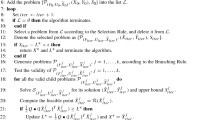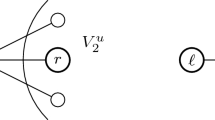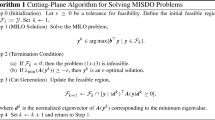Abstract
In this paper, we develop a semidefinite relaxation-based branch-and-bound algorithm that exploits the chordal sparsity patterns of the max-cut problem. We first study how the chordal sparsity pattern affects the hardness of a max-cut problem. To do this, we derive a polyhedral relaxation based on the clique decomposition of the chordal sparsity patterns and prove some sufficient conditions for the tightness of this polyhedral relaxation. The theoretical results show that the max-cut problem is easy to solve when the sparsity pattern embedded in the problem has a small treewidth and the number of vertices in the intersection of maximal cliques is small. Based on the theoretical results, we propose a new branching rule called hierarchy branching rule, which utilizes the tree decomposition of the sparsity patterns. We also analyze how the proposed branching rule affects the chordal sparsity patterns embedded in the problem, and explain why it can be effective. The numerical experiments show that the proposed algorithm is superior to those known algorithms using classical branching rules and the state-of-the-art solver BiqCrunch on most instances with sparsity patterns arisen in practical applications.


Similar content being viewed by others
Data availability statement
The datasets generated during the computational experiments are available in the Github repository: https://github.com/zhibindeng/Personal/blob/gh-pages/TestSet.zip.
Notes
It is easy to check that Properties (P3) and (P3’) are equivalent.
See https://biqcrunch.lipn.univ-paris13.fr/BiqCrunch/results for detailed numerical results of BiqCrunch and Biq Mac.
Available at https://biqcrunch.lipn.univ-paris13.fr/BiqCrunch. Our results is based on the second release of BiqCrunch.
We generated instances with different \(k=5,6,7,8\) for the given w and s and found that the proposed algorithm can solve the largest instance for \(k=8\) within 7 min, while the benchmark algorithm R2 already ran out of time limit. Hence, we did not try to find the largest possible instances that can be solved within 3 h by our algorithm for this type of sparsity pattern.
We found that, even for \(n=120\), some instances can not be solved by any of the algorithm within 3 h. Hence, the step of graph augmentation is skipped in generating disk graphs in this set.
References
Andersen, M., Vandenberghe, L., Dahl, J.: Linear matrix inequalities with chordal sparsity patterns and applications to robust quadratic optimization. In: 2010 IEEE International Symposium on Computer-Aided Control System Design (CACSD), pp. 7–12 (2010)
Arnborg, S., Corneil, D., Proskurowski, A.: Complexity of finding embeddings in a \(k\)-tree. SIAM. J. Alg. Disc. Meth. 8(2), 277–284 (1987)
Barahona, F., Grötschel, M., Mahjoub, A.R.: Facets of the bipartite subgraph polytope. Math. Oper. Res. 10(2), 340–358 (1985)
Barahona, F., Mahjoub, A.R.: On the cut polytope. Math. Program. Ser. A 36(2), 157–173 (1986)
Benati, S., Ponce, D., Puerto, J., Rodriguez-Chia, A.: A branch-and-price procedure for clustering data that are graph connected. Euro. J. Oper. Res. 297(3), 817–830 (2021)
Billionnet, A., Elloumi, S.: Using a mixed integer quadratic programming solver for the unconstrained quadratic 0–1 problem. Math. Program. Ser. A 109(1), 55–68 (2007)
Burer, S., Monteiro, R.D.C., Zhang, Y.: Rank-two relaxation heuristics for max-cut and other binary quadratic programs. SIAM J. Optim. 12(2), 503–521 (2002)
Diestel, R.: Graph Theory, 5th edn. Springer (2017)
Dunning, I., Gupta, S., Silberholz, J.: What works best when? A systematic evaluation of heuristics for max-cut and QUBO. INFORMS J. Comput. 30(3), 608–624 (2018)
Fairbrother, J., Letchford, A.N., Briggs, K.: A two-level graph partitioning problem arising in mobile wireless communications. Comput. Optim. Appl. 69(3), 653–676 (2018)
Festa, P., Pardalos, P., Resende, M., Ribeiro, C.: Randomized heuristics for the max-cut problem. Optim. Methods Softw. 17(6), 1033–1058 (2002)
Fukuda, M., Kojima, M., Murota, K., Nakata, K.: Exploiting sparsity in semidefinite programming via matrix completion I: General framework. SIAM J. Optim. 11(3), 647–674 (2001)
Gaar, E., Rendl, F.: A computational study of exact subgraph based SDP bounds for Max-Cut, stable set and coloring. Math. Program. Ser. B 183(1–2), 283–308 (2020)
Garey, M.R., Johnson, D.S.: Computers and Intractability: A Guide to the Theory of NP-Completeness. W. H. Freeman & Co., New York (1979)
Garstka, M., Cannon, M., Goulart, P.: Cosmo: a conic operator splitting method for convex conic problems. J. Optim. Theory App. 190(3), 779–810 (2021)
Goemans, M.X., Williamson, D.P.: Improved approximation algorithms for maximum cut and satisfiability problems using semidefinite programming. J. ACM 42(6), 1115–1145 (1995)
Gosz, M.: Finite Element Method: Applications in Solids, Structures, and Heat Transfer. CRC Press, Boca Raton (2017)
Grone, R., Johnson, C.R., Sá, E.M., Wolkowicz, H.: Positive definite completions of partial Hermitian matrices. Linear Algebra Appl. 58, 109–124 (1984)
Heggernes, P.: Minimal triangulation of graphs: a survey. Discrete Math. 306(3), 297–317 (2006)
Helmberg, C., Rendl, F.: Solving quadratic (0,1)-problems by semidefinite programs and cutting planes. Math. Program. Ser. A 82(3), 291–315 (1998)
Jarre, F., Lieder, F., Liu, Y., Lu, C.: Set-completely-positive representations and cuts for the max-cut polytope and the unit modulus lifting. J. Glob. Optim. 76(4), 913–932 (2020)
Jünger, M., Mallach, S.: Exact facetial odd-cycle separation for maximum cut and binary quadratic optimization. INFORMS J. Comput. 33(4), 1419–1430 (2021)
Kim, S., Kojima, M.: Second order cone programming relaxation of nonconvex quadratic optimization problems. Optim. Methods Softw. 15(3–4), 201–224 (2001)
Koster, A.C., Bodlaender, H.L., van Hoesel, S.P.: Treewidth: computational experiments. Electron. Notes Discrete Math. 8, 54–57 (2001)
Krislock, N., Malick, J., Roupin, F.: Improved semidefinite bounding procedure for solving max-cut problems to optimality. Math. Program. Ser. A 143(1), 62–86 (2014)
Krislock, N., Malick, J., Roupin, F.: Biqcrunch: a semidefinite branch-and-bound method for solving binary quadratic problems. ACM T. Math. Softw. 43(4), 1–23 (2017)
Lasserre, J.B.: A MAX-CUT formulation of 0/1 programs. Oper. Res. Lett. 44(2), 158–164 (2016)
Madani, R., Sojoudi, S., Fazelnia, G., Lavaei, J.: Finding low-rank solutions of sparse linear matrix inequalities using convex optimization. SIAM J. Optim. 27(2), 725–758 (2017)
Martí, R., Duarte, A., Laguna, M.: Advanced scatter search for the max-cut problem. INFORMS J. Comput. 21(1), 26–38 (2009)
Mosek: Mosek aps. http://www.mosek.com (2020)
Muramatsu, M., Suzuki, T.: A new second-order cone programming relaxation for max-cut problems. J. Oper. Res. Soc. Jpn. 46(2), 164–177 (2003)
Poljak, S., Rendl, F.: Solving the max-cut problem using eigenvalues. Discrete Appl. Math. 62(1–3), 249–278 (1995)
Rendl, F., Rinaldi, G., Wiegele, A.: Solving max-cut to optimality by intersecting semidefinite and polyhedral relaxations. Math. Program. Ser. A 121(2), 307–335 (2010)
Rinaldi, G.: Rudy. http://www-user.tu-chemnitz.de/ (1998)
Sliwak, J., Andersen, E.D., Anjos, M.F., Létocart, L., Traversi, E.: A clique merging algorithm to solve semidefinite relaxations of optimal power flow problems. IEEE Trans. Power Syst. 36(2), 1641–1644 (2021)
Tarjan, R., Yannakakis, M.: Simple linear-time algorithms to test chordality of graphs, test acyclicity of hypergraphs, and selectively reduce acyclic hypergraphs. SIAM J. Comput. 13(3), 566–579 (1984)
Teng, J., Jakeman, A., Vaze, J., Croke, B., Dutta, D., Kim, S.: Flood inundation modelling: A review of methods, recent advances and uncertainty analysis. Environ. Modell. Softw. 90, 201–216 (2017)
Vandenberghe, L., Andersen, M.S.: Chordal graphs and semidefinite optimization. Found. Trends Optim. 1(4), 241–443 (2014)
Waki, H., Kim, S., Kojima, M., Muramatsu, M.: Sums of squares and semidefinite program relaxations for polynomial optimization problems with structured sparsity. SIAM J. Optim. 17(1), 218–242 (2006)
Wang, J., Magron, V.: Exploiting sparsity in complex polynomial optimization. J. Optim. Theory App. 192(1), 335–359 (2022)
Wang, J., Magron, V., Lasserre, J.B.: Chordal-TSSOS: a moment-SOS hierarchy that exploits term sparsity with chordal extension. SIAM J. Optim. 31(1), 114–141 (2021)
Wang, J., Magron, V., Lasserre, J.B., Mai, N.H.A.: CS-TSSOS: Correlative and term sparsity for large scale polynomial optimization. arXiv:2005.02828 (2021)
Zhang, R.Y., Lavaei, J.: Sparse semidefinite programs with guaranteed near-linear time complexity via dualized clique tree conversion. Math. Program. Ser. A 188(1), 351–393 (2021)
Zheng, Y., Fantuzzi, G., Papachristodoulou, A., Goulart, P., Wynn, A.: Chordal decomposition in operator-splitting methods for sparse semidefinite programs. Math. Program. Ser. A 180(1), 489–532 (2020)
Acknowledgements
Lu’s research has been supported by the National Natural Science Foundation of China Grant No. 12171151. Deng’s research has been supported by the National Natural Science Foundation of China Grant No. T2293774, by the Fundamental Research Funds for the Central Universities E2ET0808X2, and by a grant from MOE Social Science Laboratory of Digital Economic Forecast and Policy Simulation at UCAS. Fang’s research has been supported by the Walter Clark Endowment at NC State. Xing’s research has been supported by the National Natural Science Foundation of China Grant No. 11771243.
Author information
Authors and Affiliations
Corresponding author
Additional information
Communicated by Bernard Ries.
Publisher's Note
Springer Nature remains neutral with regard to jurisdictional claims in published maps and institutional affiliations.
Rights and permissions
Springer Nature or its licensor (e.g. a society or other partner) holds exclusive rights to this article under a publishing agreement with the author(s) or other rightsholder(s); author self-archiving of the accepted manuscript version of this article is solely governed by the terms of such publishing agreement and applicable law.
About this article
Cite this article
Lu, C., Deng, Z., Fang, SC. et al. A New Global Algorithm for Max-Cut Problem with Chordal Sparsity. J Optim Theory Appl 197, 608–638 (2023). https://doi.org/10.1007/s10957-023-02195-3
Received:
Accepted:
Published:
Issue Date:
DOI: https://doi.org/10.1007/s10957-023-02195-3




